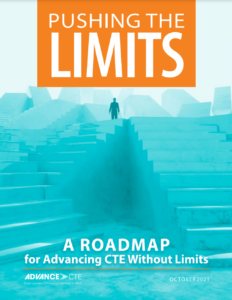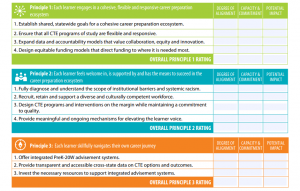 March 2022 marks one year since the release of Without Limits: A Shared Vision for the Future of Career Technical Education (CTE Without Limits). CTE Without Limits positions CTE as the catalyst for achieving a cohesive ecosystem that is responsive to each learner’s needs for college and career success.
March 2022 marks one year since the release of Without Limits: A Shared Vision for the Future of Career Technical Education (CTE Without Limits). CTE Without Limits positions CTE as the catalyst for achieving a cohesive ecosystem that is responsive to each learner’s needs for college and career success.
To celebrate this milestone, Advance CTE elevated the work of vision partners through a Twitter chat, announced three states participating in a state cohort for vision implementation, and held a vision-focused Ask an Expert session. The event delved into Advance CTE’s hallmark vision implementation resource released last fall, Pushing the Limits: A Roadmap for Advancing CTE Without Limits.
This resource recap post breaks down the roadmap resource and provides first steps for state CTE leaders to prepare for and use this comprehensive tool.
Resource Background
 Achieving CTE Without Limits is only possible through shared commitment and action among all CTE stakeholders The Pushing the Limits roadmap serves as the primary evaluation and planning tool for state and local CTE leaders to conduct a collaborative process that: a) provides an initial assessment of state policy and practice; b) identifies top areas for action; and c) develops implementation strategies for one or more vision principles.
Achieving CTE Without Limits is only possible through shared commitment and action among all CTE stakeholders The Pushing the Limits roadmap serves as the primary evaluation and planning tool for state and local CTE leaders to conduct a collaborative process that: a) provides an initial assessment of state policy and practice; b) identifies top areas for action; and c) develops implementation strategies for one or more vision principles.
The document is provided in both a combined format as well as separate by each of the five vision principles. The three to four action steps recommended for each vision principle can be evaluated by state leaders through five activities:
- Data Review: Collect and analyze data to identify gaps in data availability as well as equity and opportunity gaps for learners that will impact roadmap planning.
- State Assessment: Provides self-assessment questions to help state leaders reflect on the current alignment of policies and practice, capacity for change, and potential impact of moving the needle for each action. The completer assigns a score to each section.
- SWOT Analysis: Applies information from self-assessment questions to identify top-level Strengths, Weaknesses, Opportunities and Threats to advance each action step.
- Models and Resources: Provides sample implementation steps, policies and resources to inspire action;
- Heat Map: Scores reach assessment section in a heat map that identifies intersecting areas of high need and high capacity for change, to aid leaders in narrowing the focus of their work.
- Action Planning: Offers an action planning tool to develop SMART (Specific, Measurable, Attainable, Relevant and Time-Bound) goals and action steps in real-time, six months and a year to drive systemic change.
Getting Started
 Effective use of the roadmap requires intentional planning and collaboration. Here are five ways to get started:
Effective use of the roadmap requires intentional planning and collaboration. Here are five ways to get started:
- Select your core state or local team that includes representatives with deep experience in K-12, postsecondary and workforce policy and practice through the lens of CTE.
- Complete Advance CTE’s State Capacity Tool to determine which vision principle(s) to focus on.
- Gather data and guiding documents to inform the self-assessment, including program participation and outcomes, statewide and regional agreements across system, statewide and department initiatives and goals, etc.
- Complete the self-assessment as individual core team members and share answers prior to soliciting additional input.
- Identify priority principles and action areas to address first based on conditions in your state.
Maximizing the Resource
CTE leaders can take several steps to maximize this resource to realize systems change at all levels, including:
- Input: Receive input on the self-assessment questions beyond your core team, including learners, educators, administrators and support staff at the local, regional and state level. This can be accomplished by sharing the roadmap questions or creating a separate survey of selected questions from the roadmap in multiple choice format.
- Capacity: Align action planning to meet the capacity of state team members, partners and institutions.
- Aim Higher: At the same time, revisit your ‘dream list’ of initiatives, supports and goals and leverage the roadmap to push your work to the next level.
- Utilize Existing Collaborative Channels: Don’t reinvent the wheel; utilize board and commission meetings, workgroups, conferences and other state and local collaborative events for information gathering and roadmap completion.
Advance CTE staff are available to support CTE leaders in this important work. Visit Advance CTE’s staff web page for contact information. Visit Advance CTE’s vision web page for additional vision education, assessment and implementation resources.
Stacy Whitehouse, Senior Associate Communications and State Engagement
Tags: CTE Resources, CTE Without Limits, Data and Accountability, systems alignment

